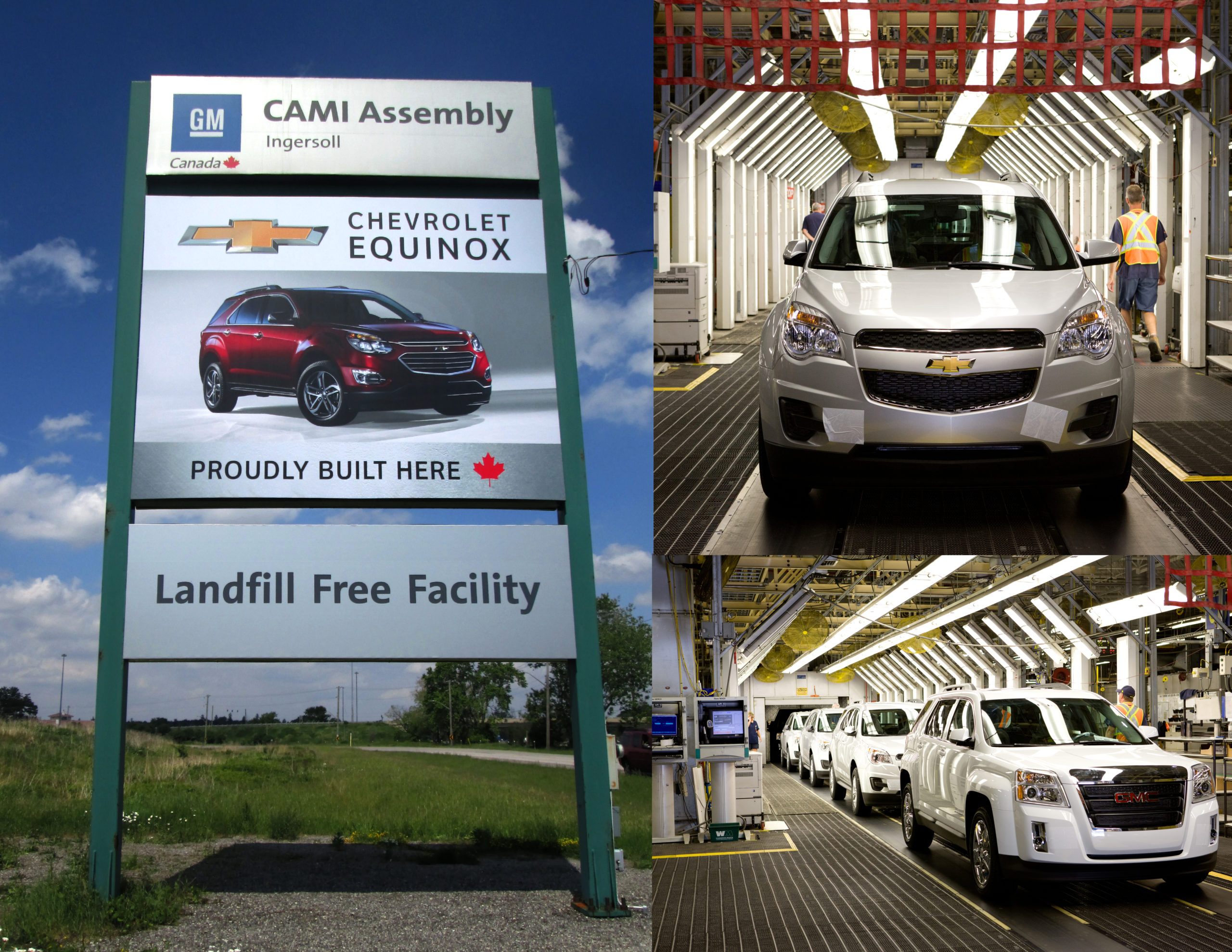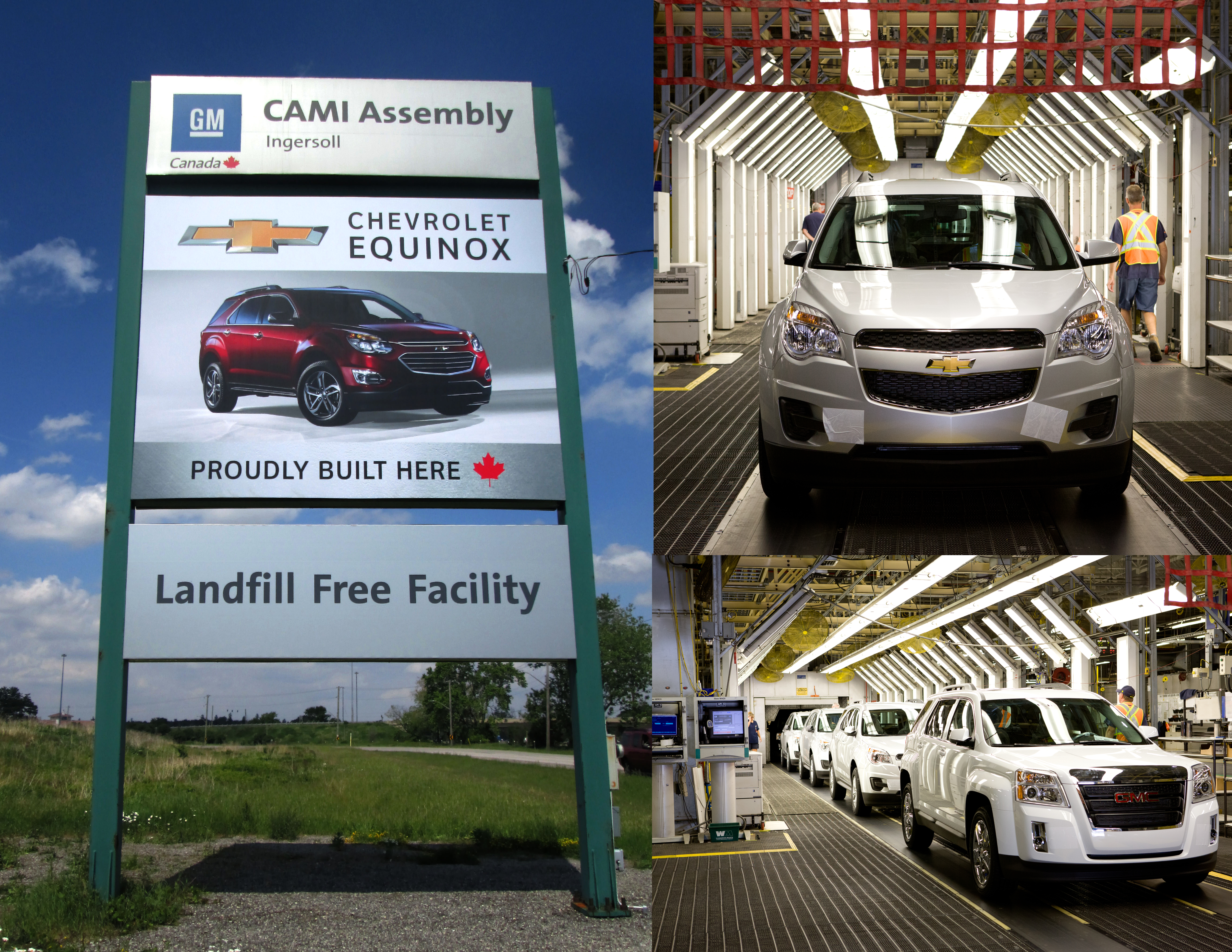General Motors of Canada Limited: CAMI Assembly Plant – Zero Waste to Landfill

Projects Sponsor
General Motors of Canada Limited’s CAMI Assembly Plant in Ingersoll, Ontario, became “Landfill-Free” in 2014 – sending zero waste to landfill from its daily operations! CAMI attained, and continues to maintain, this milestone achievement through the hard work, dedication, and resourcefulness of their entire plant team. By becoming Landfill-Free our CAMI Assembly Plant supports General Motors’ goal of having 150 Landfill-Free facilities globally by 2020 (see GM Joins White House Climate Pledge below). This commitment is part of GM’s and CAMI’s culture of continuous improvement. It makes our operations more efficient, helps conserve vital resource, and it supports the communities where we work and live.

CAMI Assembly
General Motors of Canada’s manufacturing operations include: Oshawa Assembly Plant, CAMI Assembly Plant and St. Catharines Engine and Transmission Plant. Construction on CAMI’s two million square foot plant began in 1987 with production beginning in 1989. By 1996 CAMI celebrated the very significant achievement of producing more than one million vehicles. Today, CAMI builds the Chevrolet Equinox and GMC Terrain. CAMI is registered to ISO 9002 (quality management system) and ISO 14001 (environmental management system).
CAMI embraces a team spirit environment where people enjoy working with and helping each other in order to achieve the company objectives. Decision making is delegated to people who are involved, well trained and able to make decisions which improve their jobs and the workplace – by continuously looking for ways to improve cost, performance, quality, environment, and safety.
Significant achievements include:
– Top Safety Pick by the Insurance Institute for Highway Safety
– Consumer Reports “Recommended Buy”
– J.D. Power Silver Plant Award for the Americas
– J.D. Power Compact SUV segment Winner (GMC Terrain) and 2nd place (Chevrolet Equinox)
– Achieved Landfill-Free status in 2014
GM’s Landfill-Free Program
In 2011, GM established its global 2020 Manufacturing Commitments, which included a commitment to have 100 manufacturing operations and 25 non-manufacturing sites Landfill-Free by 2020 (which this year has been revised to achieve 150 Landfill-Free facilities by 2020). Today, GM has achieved 122 Landfill-Free facilities, including GMCL CAMI (2014) and GMCL St. Catharines (2008). One family’s trash bag is more waste to landfill than 122 GM Landfill-Free facilities combined!
GM recycles or reuses 2.5 million metric tons at our facilities worldwide. Our very high rate of waste diversion reduces green-house-gas (GHG) emissions – offsets our manufacturing scope 1 (direct) and scope 2 (indirect) GHG emissions.
Our commitments and efforts are becoming recognized.
In July 2015, White House officials hosted General Motors and a dozen other companies to launch the American Business Act on Climate Pledge. The pledge represents how companies remain committed to addressing the global challenge of climate change head on.
As signers, GM pledged ongoing commitment to climate action, support for a strong Paris climate negotiations outcome, and hope that other companies will join the growing business community committed to addressing this important global issue.
The pledge aligns with GM’s actions and commitment to combatting climate change through its products and plants worldwide. As a signatory of the Ceres BICEP Climate Declaration since 2013, GM believes, and continues to prove, there is economic opportunity in addressing climate change.
“We know the world is changing and we are making bold moves to ensure we remain relevant to customers and conserve the resources our industry relies on,” said Greg Martin, GM’s executive director of sustainability who participated in the White House roundtable. “We are restructuring our entire global portfolio to maximize vehicle efficiencies and reducing carbon emissions around the globe while we meet a variety of customer needs.”
CAMI’s DRIVE to become Landfill-Free
The Objective:
By setting an aggressive project objective to become Landfill-Free, the CAMI Assembly Plant supports General Motors’ goal of having 150 Landfill-Free facilities globally by 2020. It is part of GM’s and CAMI’s culture of continuous improvement. It makes our operations more efficient, helps conserve vital resources, and it supports the communities where we work and live.
CAMI is focused on supporting the community and our customers — we all benefit from ongoing energy, water and waste reduction. CAMI’s employees, suppliers and partners worked together to develop innovative solutions to help the assembly plant achieve landfill-free.
The Steps:
1. Identify and characterize all waste streams,
2. Determine waste reduction (“engineer out the waste”) opportunities,
3. Determine reuse, recycle or recovery options on a waste stream by waste stream basis,
4. Continuous improvement.
The Method:
At CAMI every department established total waste reduction goals. By reducing waste streams the team helped offset waste diversion costs and seeking opportunities to reuse, recycle and recover all waste streams avoids placing valuable resources in landfills and meets the objective.
The Result:
All daily operational waste is diverted from landfill. 100% waste diversion! This project support’s Ontario’s waste diversion objectives and reuse and recycling avoids GHG emissions, which supports Ontario’s climate change objectives.
Overcoming Obstacles:
• Finding cost effective alternatives to landfilling
• Finding local opportunities to reduce shipping distances (this helps to reduce costs and reduces transportation GHG emissions)
• Full plant and company engagement to seek and implement opportunities to engineer out the creation of waste
• Full plant engagement to ensure a very effective plant wide “line-side” source separation program is in place and maintained to facilitate recycle and reuse of materials
External Resources:
• On site resource manager / resource management company – who supports the plant in seeking opportunities to divert waste from landfill
• Waste receiving companies who explore and develop new methods of reusing and / or recycling waste materials (resources)
The Outcome, Achieving Landfill Free:
Saves valuable resources by keeping waste materials (resources) in the value chain,
Avoids GHG emissions,
Demonstrates environmental stewardship and leadership.
















